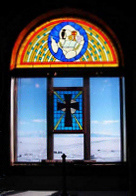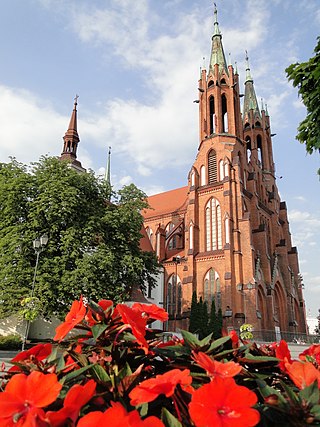| Schneekirche | |
|---|---|
 | |
 | |
| 48°53′35″N13°38′52″E / 48.8930°N 13.6477°E | |
| Location | Mitterfirmiansreut, Germany |
The Schneekirche is a church made annually from snow in Mitterfirmiansreut, in the district of Freyung-Grafenau in Bavaria, Germany.
| Schneekirche | |
|---|---|
 | |
 | |
| 48°53′35″N13°38′52″E / 48.8930°N 13.6477°E | |
| Location | Mitterfirmiansreut, Germany |
The Schneekirche is a church made annually from snow in Mitterfirmiansreut, in the district of Freyung-Grafenau in Bavaria, Germany.
In 1911, a group of villagers in Mitterfirmiansreut got the idea to build a snow church in protest that the church officials did not give them money to build one. [1] The 1910-1911 winter had left a lot of snow, so they went to work in February. Men and women worked to cut out snow blocks for their church. The finished ice church was 14m long, 7m wide and 4m high. The first worship was held on the 28th of March, 1911. The church gained attention internationally, and the group began to receive donations for construction of a stone church.
The villagers decided to build another snow church to commemorate the one hundredth anniversary of that church in 2011. However, they ran into a lack of snow and they were not able to make it to their hoped Christmas opening, but instead opened at the end of the year. [2] In the early stage, Catholic leaders[ who? ] expressed skepticism, and the local Bishop refused to consecrate it. Eventually the new ice church was built.
It was planned by architect Alfons Doeringer. [2] It cost €100,000, [3] or US $200,000 to build, using 1,400 cubic meters (49,000 cubic feet) of snow and slabs of ice. [4] The dimensions were 26 meters long and 11 meters wide with a 17-meter tower and there was space to seat 190 people. [5] Blue lighting elements were built into the ice, to enhance its appearance.
Even before the building was completed, there was a number of requests for baptisms and weddings. The nearby Catholic Bishop of Passau, Wilhelm Schraml, initially ruled out masses, baptisms or weddings from being held at the church for theological reasons; [6] worship services were allowed to be held and the church was consecrated by the local dean, Kajetan Steinbeißer. [2]
Before it melted, it was nicknamed "God's Igloo" by the Spiegel newspaper. [3]

Johann Joseph Ignaz von Döllinger, also Doellinger in English, was a German theologian, Catholic priest and church historian who rejected the dogma of papal infallibility. Among his writings which proved controversial, his criticism of the papacy antagonized ultramontanes, yet his reverence for tradition annoyed the liberals.

In Christian denominations that practice infant baptism, confirmation is seen as the sealing of the covenant created in baptism. Those being confirmed are known as confirmands. For adults, it is an affirmation of belief. It involves laying on of hands.

Landshut is a town in Bavaria in the south-east of Germany. Situated on the banks of the River Isar, Landshut is the capital of Lower Bavaria, one of the seven administrative regions of the Free State of Bavaria. It is also the seat of the surrounding district and has a population of more than 75,000. Landshut is the largest city in Lower Bavaria, followed by Passau and Straubing, and Eastern Bavaria's second after Regensburg.

The Mariavite Church is today one of two independent Christian churches collectively known as Mariavites which first emerged from the religious inspiration of Polish noblewoman and nun Feliksa Kozłowska (1862-1921) in the late 19th-century. Initially, it was a renewal movement seeking reform in Polish Catholicism. The movement was an attempt to replicate the simplicity of the life of Mary, in Latin, qui Mariae vitam imitantur,, thus vita Mariae, the Life of Mary, gave the movement its name.

Chrism, also called myrrh, myron, holy anointing oil, and consecrated oil, is a consecrated oil used in the Catholic, Eastern Orthodox, Oriental Orthodox, Assyrian, Nordic Lutheran, Anglo-Catholics, Old Catholic, and Latter Day Saint churches in the administration of certain sacraments and ecclesiastical functions.

Consecration is the transfer of a person or a thing to the sacred sphere for a special purpose or service. The word consecration literally means "association with the sacred". Persons, places, or things can be consecrated, and the term is used in various ways by different groups. The origin of the word comes from the Latin stem consecrat, which means dedicated, devoted, and sacred. A synonym for consecration is sanctification; its antonym is desecration.

An ice hotel is a temporary hotel made up of snow and sculpted blocks of ice. Ice hotels, dependent on sub-freezing temperatures, are constructed from ice and snow and typically have to be rebuilt every year. Ice hotels exist in several countries, and they have varying construction styles, services and amenities, the latter of which may include ice bars, restaurants, chapels, saunas and hot tubs.
Ex opere operato is a Latin phrase meaning "from the work performed" and, in reference to sacraments, signifies that they derive their efficacy, not from the minister or recipient, but from the sacrament considered independently of the merits of the minister or the recipient. According to the ex opere operato interpretation of the sacraments, any positive effect comes not from their worthiness or faith but from the sacrament as an instrument of God.

The Neocatechumenal Way, also known as the Neocatechumenate, or NCW is an itinerary/process in the Catholic Church for faith formation. It is inspired by the catechumenate of the early Catholic Church where converts from paganism were prepared for baptism through a process of faith formation. This post-baptismal formation helps deepen the faith for adults that have already been baptized, and provides basic instruction to those that are far from the Church. This itinerary of formation adapts the rites of the Rite of Christian Initiation of Adults (RCIA) for those that have already been baptized, without repeating the sacrament of baptism.

François Norbert Blanchet was a French Canadian-born missionary priest and prelate of the Catholic Church who was instrumental in establishing the Catholic Church presence in the Pacific Northwest. He was one of the first Catholic priests to arrive in what was then known as the Oregon Country and subsequently became the first bishop and archbishop of the Archdiocese of Oregon City.
Catholicity is a concept pertaining to beliefs and practices that are widely accepted by numerous Christian denominations, most notably by those Christian denominations that describe themselves as catholic in accordance with the Four Marks of the Church, as expressed in the Nicene Creed formulated at the First Council of Constantinople in 381: "[I believe] in one, holy, catholic, and apostolic Church." The English adjective catholic is derived from the Ancient Greek adjective καθολικός, meaning "general", "universal". Thus, "catholic" means that in the Church the wholeness of the Christian faith, full and complete, all-embracing, and with nothing lacking, is proclaimed to all people without excluding any part of the faith or any class or group of people. An early definition for what is "catholic" was summarized in what is known as the Vincentian Canon in the 5th century Commonitory: "what has been believed everywhere, always, and by all."
In keeping with its prevailing self-identity as a via media or "middle path" of Western Christianity, Anglican sacramental theology expresses elements in keeping with its status as a church in the catholic tradition and a church of the Reformation. With respect to sacramental theology the Catholic tradition is perhaps most strongly asserted in the importance Anglicanism places on the sacraments as a means of grace, sanctification and forgiveness as expressed in the church's liturgy.

Religion in Antarctica is largely dominated by Christianity, with churches being the only religious buildings on the continent. Although used regularly for Christian worship, the Chapel of the Snows has also been used for Buddhist and Baháʼí Faith ceremonies. Some of the early religious buildings are now protected as important historical monuments.
A personal ordinariate for former Anglicans, shortened as personal ordinariate or Anglican ordinariate, is an ordinariate, a canonical structure within the Catholic Church established in order to enable "groups of Anglicans" and Methodists to join the Catholic Church while preserving elements of their liturgical and spiritual patrimony.
This is a glossary of terms used within the Catholic Church. Some terms used in everyday English have a different meaning in the context of the Catholic faith, including brother, confession, confirmation, exemption, faithful, father, ordinary, religious, sister, venerable, and vow.

The Cathedral of Saint Peter is the mother church of the Roman Catholic Diocese of Wilmington. Located on West 6th Street in Wilmington, Delaware. the cathedral is in the Quaker Hill Historic District of the city.

There are seven sacraments of the Catholic Church, which according to Catholic theology were instituted by Jesus Christ and entrusted to the Church. Sacraments are visible rites seen as signs and efficacious channels of the grace of God to all those who receive them with the proper disposition.
The Open Episcopal Church (OEC) is a liberal Christian denomination. It has bishops in England and Wales and clergy throughout the United Kingdom and internationally. It has over 29,000 members.
The Ecumenical Catholic Church (ECC/ICE) is an Independent Catholic church established in Santa Ana, California by Mark Steven Shirilau and Jeffrey Michael Lau, in 1987. Adhering to conventional Latin Catholic Trinitarian theology and professing the Nicene Creed, the Ecumenical Catholic Church practices a liturgy similar to the Pauline Mass. Also considered an offshoot of the Brazilian Catholic Apostolic Church, the ECC differentiates from Roman Catholicism and independent Brazilian Catholicism through affirming and ordaining persons within the LGBTQ+ community.

The Cathedral Basilica of the Assumption of the Blessed Virgin Mary also called Białystok Cathedral is a Roman Catholic cathedral in the city of Bialystok in Poland. It was designed by architect Józef Pius Dziekoński. The three-nave church is 90 meters long and can accommodate 9,500 worshipers. The two towers reach 72.5 meters high. It is the main church of the Archdiocese of Bialystok and acquired the status of basílica in 1985 by decision of Pope John Paul II.